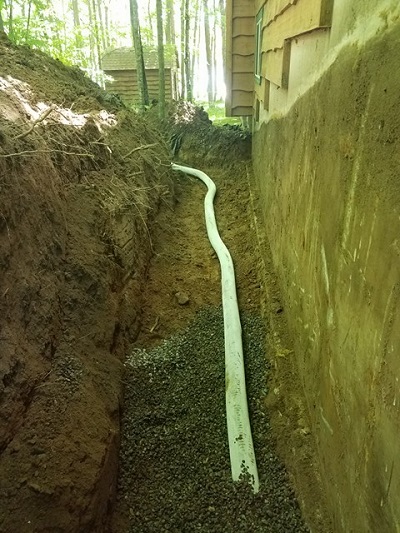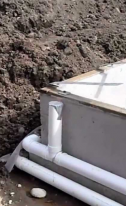Water is the leading cause of nearly all foundation problems. Water can seep into the ground near a foundation for many reasons. This moisture causes the soil to swell and puts pressure on the foundation. The resulting pressure can cause everything from hairline cracks to deterioration to flooding, depending on the construction and the amount of water involved. Getting moisture under control before it disrupts or compromises the foundation or contents of a home will save thousands or even tens of thousands of dollars.
New build foundations
New foundations should be treated during the construction phase, as prevention is always the most desirable option for moisture control. Along with an exterior drainage system and proper grading, a correctly treated foundation will redirect and eliminate the problem of moisture in 99% of all residences. Even basements which don’t have a moisture issue due to drought or low groundwater level during the building phase should be created to be structurally sound if they’re in an area known for moisture. As the water table rises, groundwater moisture can seep into areas which were never problematic in the past and create havoc.
While building a basement during new construction only costs about half of what a ground level space of the same square footage, it adds an average of $23,000 to the value of a home. For this reason, a basement is a desirable commodity in new buildings. As a bonus, the basement is not relegated to specific tasks like many other rooms of a home, which leaves a family or business free to choose their specific functional use of the basement, making it an extremely worthwhile investment.
However, a wet basement or one with a musty odor, sticking doors, seepage, or other visible signs of moisture have the potential to create tremendous damage to the basement, its contents, and the foundational structure without intervention.
Existing foundations
Ideally, moisture prevention treatments should be done during the construction phase. This is not always possible since many homes older homes were never treated for moisture prevention during construction as they are now in new home construction. Fortunately, mainly when caught early, most moisture-related problems can be corrected. But, repairing a damaged foundation simply isn’t enough: the water problem has to be dealt with efficiently to prevent new damage. Early detection and treatment is the key to keeping a moisture problem from causing extensive damage.
Signs of moisture trouble
- a door or window which won’t latch or sticks.
- Mold or a musty or mildew odor.
- Cracks which appear in flooring or walls. Especially horizontal cracks over ¼” or stair step cracks
- Bulging or curving of walls or flooring
- Walls which are no longer straight or true
- A foundation which easily chips or crumbles when prodded with a metal pick.
- Puddles in the basement or wet/rotting framing.
While this list isn’t all-inclusive, it does offer some of the signs a homeowner can watch for if he is suspicious of moisture issues. One caveat: many of the symptoms listed here are also indicators for other factors unrelated to moisture issues. Unfortunately, actual water or puddles is one of the last signs of a moisture problem. The first crucial step in repairing the problem is to find the source of the water. Whether the cause is groundwater, rain, or a plumbing failure, the area then must be dried out completely to prevent further damage and facilitate the repair.
Cleaning, patching, crack sealing, and reinforcing may all be part of the repair process before waterproofing.
Efflorescence
Efflorescence, the white salt which appears on unsealed concrete, is the result of moisture pushing salts through the concrete or mortar, where it reacts with carbon dioxide to form crystals. It can look fluffy or fuzzy. It’s common in new buildings, however, if efflorescence suddenly appears after some time has passed, it’s indicative of a moisture problem.
Hydrostatic pressure
Hydrostatic pressure as related to concrete is the presence of moisture in concrete and its effects. As concrete dries, the resulting airways left where the water evaporates during the drying process are left exposed if concrete is left untreated. Standing water combined with the pressure of a slab below the soil level can cause the water to wick up into and fill these holes, which are tiny and porous. While it is true that water responds to gravity, the pressure of saturated ground may leave the water with nowhere else to go but into the concrete. Once inside, it will start to damage and degrade the concrete.
While hydrostatic pressure is often a problem, groundwater isn’t the only source of moisture which may be affecting the foundation or slab. For this reason, it’s essential to discover the actual cause of the water before blaming hydrostatic pressure. An underground water leak, a faulty sprinkler system, or even improperly installed or poorly cured concrete can cause similar problems.
The effects of hydrostatic pressure
The effects of hydrostatic pressure could be something as small as light efflorescence between tiles, small puddles, cracks in concrete, buckling walls, compromised foundation, and can deteriorate to flooding.
Interior vs. exterior waterproofing options
While interior waterproofing options are almost always more economical than exterior waterproofing, interior waterproofing is a process which allows that water is already in the structure. Interior waterproofing addresses hydrostatic pressure problems in the floor. An exterior waterproofing system never permits the water into the building in the first place which makes it the proactive. However, exterior waterproofing does cost more and may affect the power and water lines, and any landscaping elements which need to be moved during waterproofing.
Foundation drainage systems
Foundation drainage systems are designed to prevent or remove surface or subsurface water. A correctly installed foundation drainage system can prevent years of trouble and water damage.
Good drainage is essential in preventing foundation problems. French drains, perimeter drains and footing drains (drain tiles) all have applications depending on the situation. Drain pipes redirect water away from the foundation of a home to a sump pump to minimize the potential for standing water, flooding, soil expansion, and damage. A well-crafted and adequately installed drainage system lasts for decades and does a phenomenal job of keeping the foundation and basement moisture free, notably if it installed during the construction phase.
It’s essential that roof gutters are not directed into the building footing drains, as, if the system becomes suddenly overloaded, the water from the roof will back up the building footing drain and end up flooding the basement.
Older drain pipes can be prone to blockages such as mud or become clogged with soil. A drain pipe can be dug up at the house end and flushed with high-pressure spray or rooter to unclog the blockage, but a cracked or crushed drain pipe will have to be replaced.
Residential and commercial sump pumps
While residential and commercial sump pumps differ widely, the result is that the following are the overall goals of a sump pump:
- Remove moisture away from the building to protect the structural integrity of the building.
- Keeping the contents of the building safe
- Preventing the people who work or live in the building from suffering as a result of water-related problems or health issues.
Water always comes with the potential to cause tremendous damage to surrounding structures, including mold, rot, and efflorescence. Sump pump installation costs vary depending on the sump pump drainage system.
A battery-powered backup sump pump for use during power outages may be indicated depending on the situation. Sump pumps are especially needed during storms, which is precisely when the electrical power is most likely to fail.
Commercial sump pump options and costs are determined by the size of the building, the amount of space available for sump pump operations, costs, and backup sump pump requirements.




